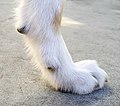Dewclaw
Dewclaw refers to a digit – often likened to a thumb or a big toe in humans – on the leg of many mammals, birds, and reptiles. It is commonly found higher on the leg than the main part of the foot, with some species having it well-adapted for specific functions, while in others, it may be more vestigial in nature.
Anatomy and Function[edit]
The dewclaw in most mammals is a rudimentary digit, and in some cases, it may not be connected to the other digits by bone at all. In dogs, the dewclaw is equivalent to a human thumb, although it is not as functional. It is located on the inner side of the leg, above the foot. For certain breeds, the dewclaw is kept intact to prevent injuries during running or hunting, as it can provide additional traction and helps to stabilize the carpal (wrist) joint. However, in some breeds, the dewclaw is removed, often for cosmetic reasons or to prevent potential injuries if the claw gets caught on something.
In cats, the dewclaw is present on the front paws and plays a crucial role in their gripping and climbing abilities. Unlike dogs, the dewclaw in cats is more functional and is used to catch and hold prey.
Birds also have a form of dewclaw, known as the "hallux," located at the back of the foot, which aids in perching.
Evolutionary Perspective[edit]
The presence of dewclaws in different species is a subject of interest in evolutionary biology. It is believed that dewclaws are the remnants of what were once more functional digits. Over time, as species evolved and adapted to their environments, the necessity for these digits diminished, leading to their current form. In some cases, the dewclaw has adapted to serve new purposes, while in others, it remains a largely vestigial structure, with little to no apparent function.
Surgical Removal[edit]
The practice of dewclaw removal, particularly in dogs, is somewhat controversial. Proponents argue that removal prevents future injuries, especially in active dogs, where the dewclaw might get caught or torn. Critics, however, suggest that with proper care and management, the risks associated with keeping the dewclaw are minimal. The decision to remove the dewclaw often depends on the breed, the dog's lifestyle, and the advice of a veterinarian.
Controversies and Considerations[edit]
The debate over dewclaw removal touches on broader issues of animal welfare and the ethics of performing surgical alterations on pets for non-medical reasons. Some countries have regulations or guidelines regarding such practices, emphasizing the need for a balanced approach that considers the well-being of the animal.
Conclusion[edit]
The dewclaw is a fascinating aspect of mammalian anatomy, offering insights into the evolutionary history and adaptations of various species. While its function and importance may vary, understanding the dewclaw's role in animal physiology and movement can contribute to better animal care and welfare practices.
-
Dewclaw
-
Dewclaw
-
Dewclaw
-
Dewclaw
-
Dewclaw
Ad. Transform your life with W8MD's Budget GLP-1 injections from $75


W8MD offers a medical weight loss program to lose weight in Philadelphia. Our physician-supervised medical weight loss provides:
- Weight loss injections in NYC (generic and brand names):
- Zepbound / Mounjaro, Wegovy / Ozempic, Saxenda
- Most insurances accepted or discounted self-pay rates. We will obtain insurance prior authorizations if needed.
- Generic GLP1 weight loss injections from $75 for the starting dose.
- Also offer prescription weight loss medications including Phentermine, Qsymia, Diethylpropion, Contrave etc.
NYC weight loss doctor appointmentsNYC weight loss doctor appointments
Start your NYC weight loss journey today at our NYC medical weight loss and Philadelphia medical weight loss clinics.
- Call 718-946-5500 to lose weight in NYC or for medical weight loss in Philadelphia 215-676-2334.
- Tags:NYC medical weight loss, Philadelphia lose weight Zepbound NYC, Budget GLP1 weight loss injections, Wegovy Philadelphia, Wegovy NYC, Philadelphia medical weight loss, Brookly weight loss and Wegovy NYC
|
WikiMD's Wellness Encyclopedia |
| Let Food Be Thy Medicine Medicine Thy Food - Hippocrates |
Medical Disclaimer: WikiMD is not a substitute for professional medical advice. The information on WikiMD is provided as an information resource only, may be incorrect, outdated or misleading, and is not to be used or relied on for any diagnostic or treatment purposes. Please consult your health care provider before making any healthcare decisions or for guidance about a specific medical condition. WikiMD expressly disclaims responsibility, and shall have no liability, for any damages, loss, injury, or liability whatsoever suffered as a result of your reliance on the information contained in this site. By visiting this site you agree to the foregoing terms and conditions, which may from time to time be changed or supplemented by WikiMD. If you do not agree to the foregoing terms and conditions, you should not enter or use this site. See full disclaimer.
Credits:Most images are courtesy of Wikimedia commons, and templates, categories Wikipedia, licensed under CC BY SA or similar.
Translate this page: - East Asian
中文,
日本,
한국어,
South Asian
हिन्दी,
தமிழ்,
తెలుగు,
Urdu,
ಕನ್ನಡ,
Southeast Asian
Indonesian,
Vietnamese,
Thai,
မြန်မာဘာသာ,
বাংলা
European
español,
Deutsch,
français,
Greek,
português do Brasil,
polski,
română,
русский,
Nederlands,
norsk,
svenska,
suomi,
Italian
Middle Eastern & African
عربى,
Turkish,
Persian,
Hebrew,
Afrikaans,
isiZulu,
Kiswahili,
Other
Bulgarian,
Hungarian,
Czech,
Swedish,
മലയാളം,
मराठी,
ਪੰਜਾਬੀ,
ગુજરાતી,
Portuguese,
Ukrainian




